Stickers are a quick and inexpensive way to add a personal touch to your belongings. But, is it OK to put them on a guitar?
In this article, I’ll show you the reasons for and against putting stickers on your guitar, so that you can make an informed decision for yourself. Whether you should or shouldn’t put stickers on your guitar is completely down to you.
I’ll also cover the types of stickers you should use, where’s best to put them, and even how to remove old stickers from your guitar.
Benefits of putting stickers on your guitar
Stickers have been featured on the guitars of countless musical icons over the years, like Tom Morello, James Hetfield, Kurt Cobain, Joan Jett, and Paul Gilbert to name a few. Not only do they add some flair to your guitar, but they can have practical uses, too.
Decoration and personalization
Playing guitar is all about expressing yourself, and stickers are a quick and effective shortcut to showing off your personality. Not only do they look cool, but they can let people know about your other hobbies, interests, or beliefs.
From Billie Joe Armstrong and Joan Jett’s punk-rock approach, to Tom Morello and Woody Guthrie’s political messages, putting stickers on a guitar is a great way to show the world what matters to you, and make a guitar feel like your guitar.
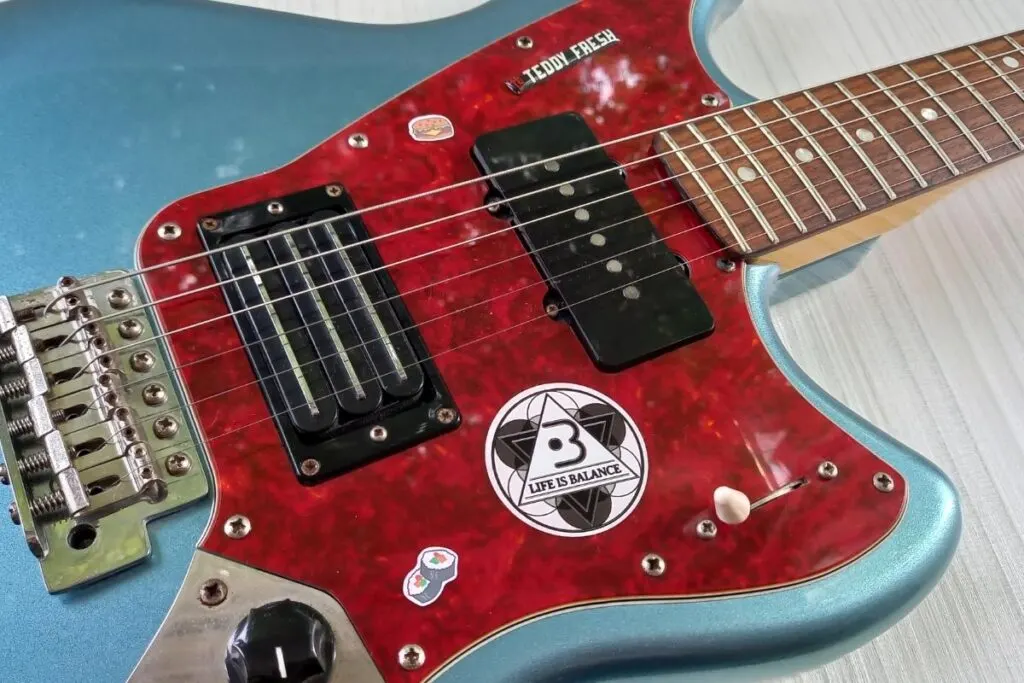
But, it doesn’t have to all be about personality. Stickers can also be used to cover up any nasty bumps or scratches. You can even get guitar stickers that cover the entire body of the guitar. These “body wraps” can be a great budget option to refresh, renew, or transform your guitar’s finish.
Learning the fretboard
Aesthetics aside, stickers can also have a practical use to help guitar players learn the fretboard.
Specialised stickers can be put on the fretboard that show which frets produce which notes across the whole neck. This type of sticker is a great resource for beginners to help them get to grips with the neck. They’re also great for any guitarist looking to freshen up their knowledge on notes!
If you’re interested, you can check out NeckNotes here on Amazon.
It won’t affect the guitar’s tone
If you want to put stickers on your guitar but are concerned about affecting the tone: there’s no need to panic!
Putting stickers on your guitar doesn’t change the guitar’s tonal quality. This is true for both acoustic and electric guitar and bass. According to the guitar experts at Fender, the tonal difference of putting stickers on your guitar is “negligible”.
That being said, it is important to keep your stickers out of the way of your strings as they can cause string buzzing and difficulty with playability.
Drawbacks of putting stickers on your guitar
As with anything, there are a couple of downsides to stickers that are worth knowing before putting them onto your guitar.
Damage to the finish
The biggest downside of stickers is that they can damage your guitar’s finish. As the glue dries and ages, it becomes firmly stuck to your guitar. When it comes to peeling off the sticker, you might end up taking some of your guitar’s paint with it!
Stickers can also prevent wear, meaning that some patches are unworn by friction or sun damage. While this sounds like a good thing, it actually creates an uneven finish on the guitar. Think of it like moving a painting on a wall – the space behind the painting always looks newer! Not only this, but the glue residue itself can stain your guitar, causing unsightly splotches.
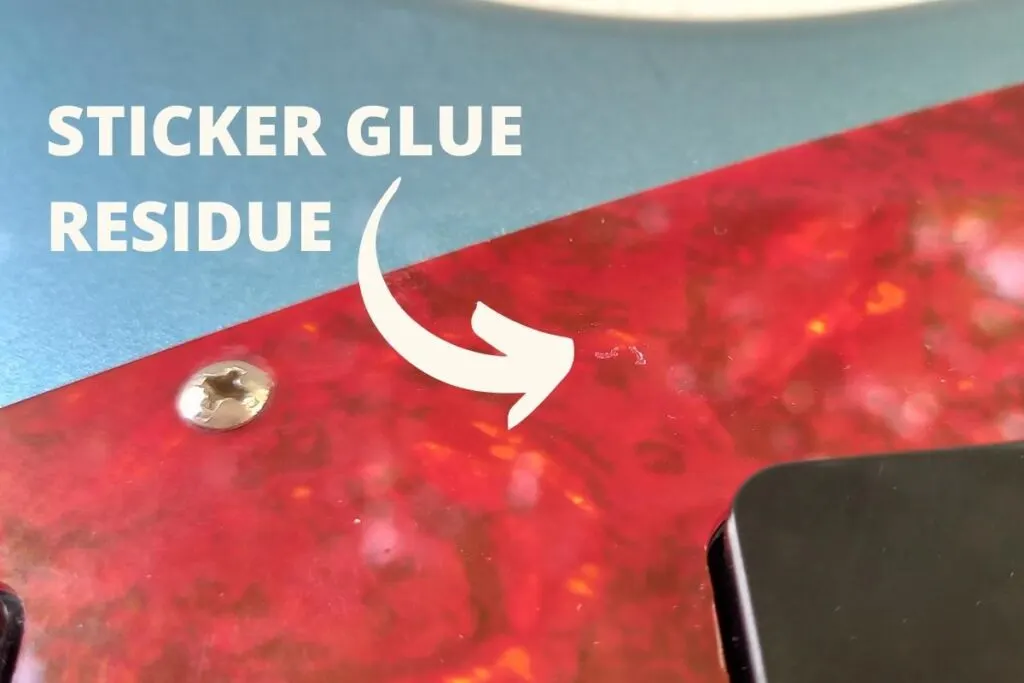
Depending on how heavy-handed you are, the process of removing stickers can also damage your guitar. Using abrasive materials or scrapers to remove stickers, or using the incorrect solvent to remove the glue, can be disastrous for your guitar.
Devalues the guitar
If you’re looking to sell your guitar later down the road, then stickers can impact its resale price. Generally speaking, guitars sell for more money when they have as little wear-and-tear as possible. Stickers will be seen as a “defect”, much like a bump or scratch would, and will knock off some money.
For this reason, it’s best to use stickers on cheaper guitars as they’re less likely to have a high resale price to begin with. You can also put stickers in a place where they can easily be removed.
Question: Do you prefer guitars with or without stickers? Leave a comment down below!
Where to put stickers on a guitar
As I said at the beginning, it’s ultimately your choice where to put your stickers on your guitar. But, some locations are better than others to keep your guitar sounding good, and keeping your finish safe.
Putting stickers on your guitar’s pickguard, or scratchplate, is a good way to decorate your guitar while keeping the paint safe. And, as they’re on the front of your guitar, you’ll still be able to show your stickers off!
Pickgaurd’s can still become damaged and worn by the glue, but they’re generally less sensitive than the painted finish of your guitar. They’re also a lot easier to replace they do become damaged in any way!
That being said, it’s your guitar and it’s your choice where you put your stickers.
I would, however, recommend not putting stickers on your fret wire (the metal bits on your frets). You’ll want a clean contact point between your guitar string and the fret wire, otherwise you can get fret buzz and playability problems.
Alternative ways to display your stickers
Personally, I don’t like putting stickers directly onto my guitar’s, as I prefer the look of a plain guitar.
Instead, I put stickers on my other guitar equipment like my pedalboard case! It’s still a great way to personalize my gear, but keeps my guitar safe and sound. Another great choice is to put stickers on your amplifier or guitar cases.
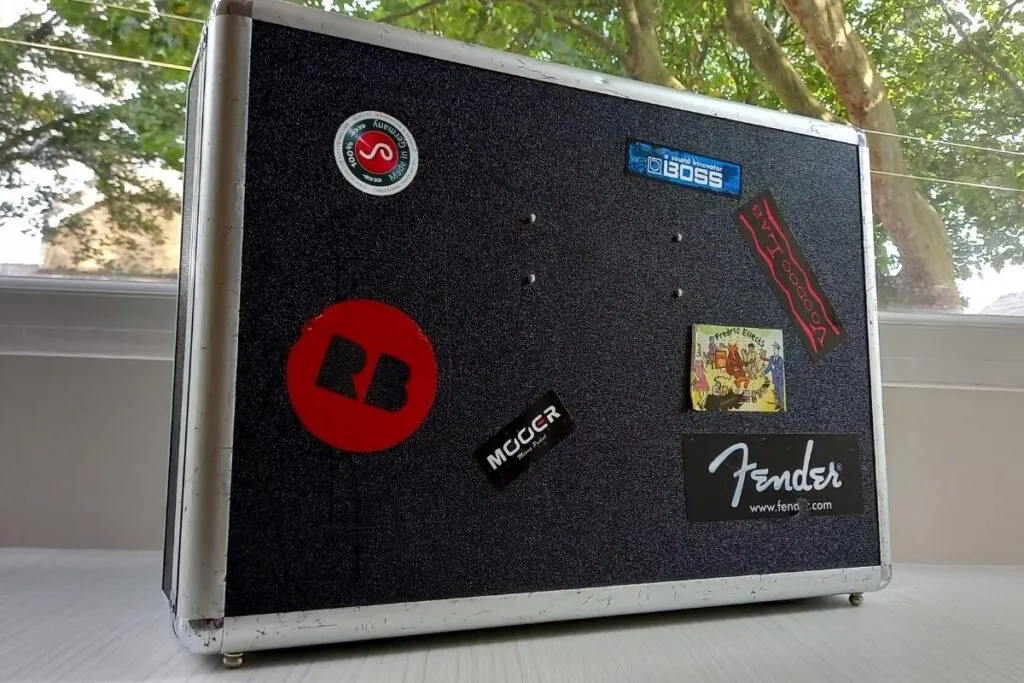
If you want your stickers more prominently displayed, you can put on your guitar strap! Again, this keeps your guitar’s finish protected but they can still be seen when you’re on stage or practicing. If your strap is made of fabric, you can even add some pins and badges!
What types of stickers should you use on guitars?
Vinyl stickers with a glossy finish are better for guitar as they’ll last longer. The durable surface protects the sticker from everyday wear-and-tear. Paper stickers, while cheaper, are much more likely to become damaged from moisture (like from sweat), fading (from sun damage), or friction (like from strumming).
Vinyl stickers are more often better quality as well. So, your designs will have more vibrant colors and “pop” more on your guitar.
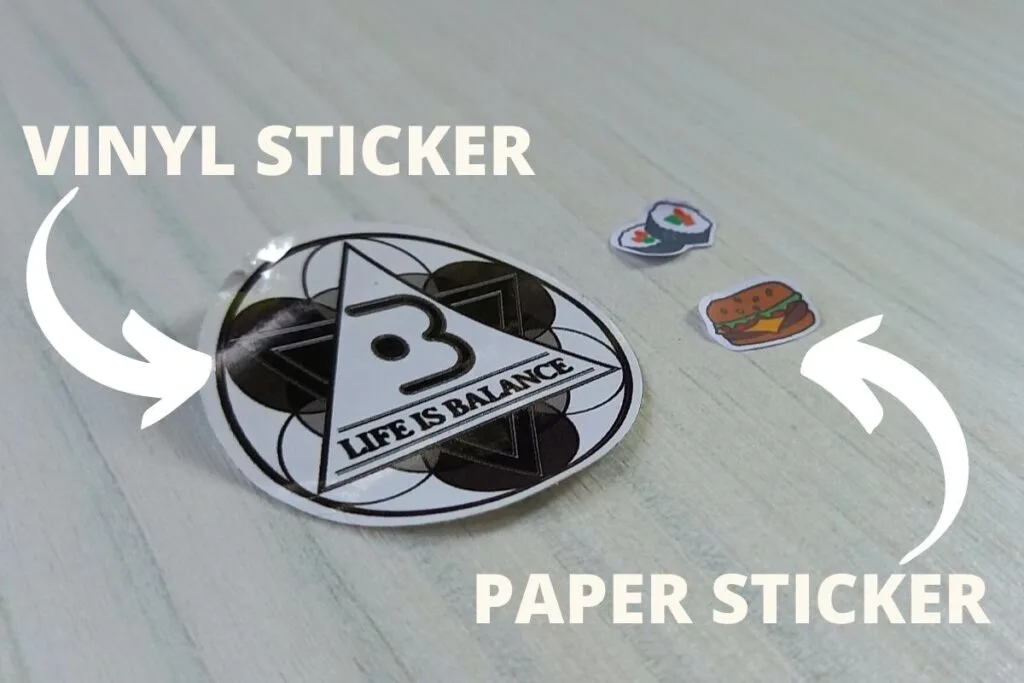
How to safely remove stickers from your guitar
If you’re looking to put stickers on, or have purchased a guitar with stickers on, it’s good to know how to take them off.
This is the riskiest part of having a sticker on your guitar, as removing it can easily damage your guitar’s finish. So, here are my golden rules:
- Don’t scrape them off
- Don’t use anything abrasive (e.g. wire wool)
- Don’t use the wrong type of solvent
All of these things can damage your guitar’s finish.
The best thing you can do, and what I recommend doing, is to take your guitar to your local repair shop. They will have plenty of experience with removing stickers, and the right equipment for the job.
If you don’t want them to do the work, they’ll at least be able to advise of the right type of solvent to use for removing your stickers. Solvent is used to remove the sticky glue residue left by older stickers. Most of the time, this comes off with a damp (damp – not wet!) cloth. But, older or stronger glue will need a solvent to dissolve the glue to fully remove it. The problem is, these solvents can also remove your guitar’s finish!
So, using the correct solvent for your guitar is essential. The folks down at your local guitar shop will be able to advise which solvent you need for your guitars finish. Don’t guess, and don’t go generic. You might end up doing more harm than good!
DIY approach to removing stickers
If you want to try removing a sticker from your guitar at home, then follow these steps:
- Soak a cloth in warm water and wring it out thoroughly until the cloth is only damp. There should be no water running from it
- Place the cloth on top of the sticker for one minute. This will start to loosen the glue.
- Now, remove the cloth and try peeling the sticker off on one of the edges with your hands.
- Once the sticker is removed, use small circular motions to remove any leftover glue residue.
If the sticker can’t be removed this way, resist the urge to use more force or scrape it! You’ll likely end up damaging your guitar’s finish. Instead, try repeating the process, holding the cloth on the sticker for longer.
If this still doesn’t work, then call your local guitar repair shop (any store that sells guitars will likely have one) and book an appointment to get it looked at.
Summary
Stickers are a great way of showing off your personality, and are a cost effective way to personalize your guitar.
If you’re worried about the potential damage or staining from stickers, I recommend putting them on your guitar’s pickguard, or other items such as your guitar strap, pedalboard, or amplifier.
If you’re tired of your old stickers and want them removed, I strongly recommend taking your guitar to a professional repair shop. The few dollars spent getting them removed will be a lot cheaper than getting your finish repaired!
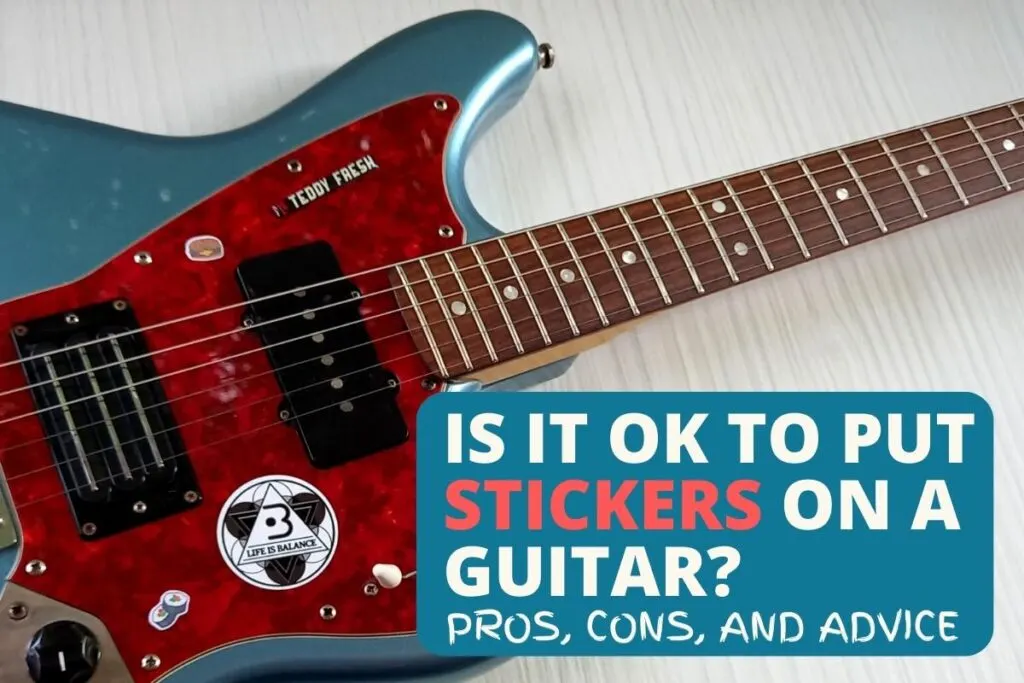

Conor is a music producer, multi-instrumentalist, and all-round enthusiast from the UK with over 15 years of experience. He’s the founder and sole-content creator for the roundtable audio blog and YouTube channel.
